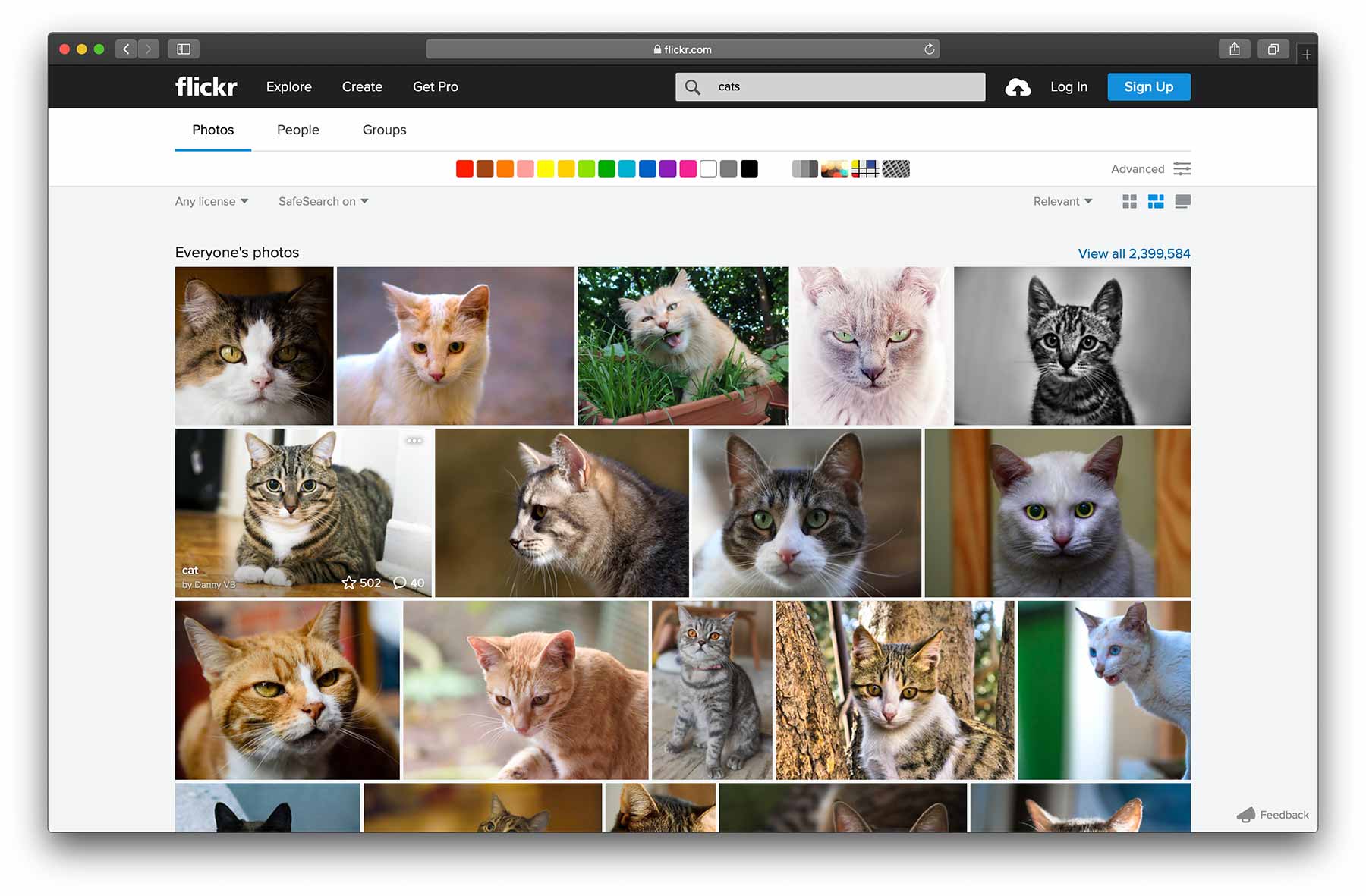There are two main reasons people choose stock photography for their website. They don’t have the time, or the budget, to hire a photographer and conduct a proper photo shoot. Happily, stock photography exists for situations like these. The trick is to choose images that don’t look stock (i.e. generic), while still coming in on budget.
Good stock imagery must build a customer’s trust in your company, set you apart from your competitors, and support your overall brand. In this article, I’ll explain why all of this mushy stuff is important; where to find, and how to pick, good images; and, what you can expect to pay for them.
Hey, I know we just met, but...
Visitors to your site make decisions about you in a split-second based on what they see. If the images on your site are low-quality, or too generic looking, it’s going to raise doubts in their minds about the quality of your product. It’s the same feeling you should be getting when you walk into a dirty, run-down restaurant. If they don’t care enough to keep up appearances, how well are they preparing the food?

Spend a little extra time looking for images that actually work *for* your business. Don’t phone it in and grab the first image of a girl smiling blankly and wearing a headset for your contact us page. Go beyond the first page of results. Try similar but different search terms. Check more than one site. When you find an image you like, look at the recommended images that will be brought up with it. A little extra effort here says that your company not only pays attention to how it presents itself, but also to how your product is made.
Keep moving. Nothing to see here.
Your potential customers are “speed dating” you when they are browsing your site, and your competitors’ sites. Being memorable in this figurative online speed dating metaphor is as important as being memorable in literal speed dating (or Tinder... or whatever the kids are doing these days...) in real life. Dull and forgettable goes home to an empty apartment, frozen pizza and *M*A*S*H* reruns. Memorable and distinct goes home to... well, they may not go home at all, if you catch my drift.

The internet is awash in websites with the same boring layouts, similar sounding text, and familiar images. Being part of this malaise is the last thing you want. Look for images with interesting compositions, manipulated colors, or unusual processing. It can be wild or mild, but pick something that shows a visitor to your site that you are worth paying attention to. This may mean spending a little more, but if you can grab their attention long enough for them to stop on your site, then the investment was worth it.
I was told there would be ribs?
So know that you know you need to look for eye-stopping images it’s important to not take it too far and go “off brand”. If you are invited to a bar-be-cue, and then served kale salad, you would (justifiably) wonder what the “h” “e” double hockey sticks is going on. Are you even at the right party?
Don’t inadvertently play this same dirty trick on your customers by using photography that looks different on all your marketing materials. You might be surprised at how often a potential sale is derailed because the pictures in the ad were so different from the pictures on the website, that the viewer thought they were at the wrong site. Consistent photography confirms in your visitor’s mind that they are still looking at the business or product they want to know more about.
Stock Options
Today, there are numerous places to get great images, and about as many ways to pay for them. As with most things in life, if you are willing to pay a little more, you are going to get better results. In most cases it’s not necessary to pay top dollar, but if you are serious about standing out from the crowd (and you should be) then pay a little more to get images most people will be too chintzy, or lazy, to spring for.
The New Kids On The Block
You may have heard of Pexels and Unsplash by now, two relative new comers on the stock photo scene. Both services allow for photographers from around the world to have their work published for either a cut of your membership fee, or simply a by-line credit.
These sites are fantastic for finding low-cost high-impact images. However, the depth of subjects covered is kind of shallow. If you need airy nature scenes, gritty street photography, arty textures, “gram-worthy” food, or a painstakingly arranged still-life of IKEA knick-knacks — then they have you more than covered. Where it gets trickier is finding “every day” images. For example, doctor helping a patient; or, a machinist operating a lathe; or, anyone working on anything but the latest MacBook Pro.
Get off my stock image of a lawn!
For subjects that might be more suited to a business than to your niece’s travel blog, sites such as iStockPhoto, Shutter Stock, or Adobe Stock are a better bet. These three sites are the grizzled old survivors of decades of mergers and buyouts in the lucrative world of stock photography.

They all have massive libraries of photos, however, the quality can still swing wildly from excellent to “avoid like the plague”. The trade-off is that you will almost certainly have many images to choose from, no matter what subject matter you are looking for.
Hey, remember Flickr?
By the way, Flickr still exists. The one-time king-of-the-hill of image sharing websites is still around! I only mention it because almost all photographs on Flickr can be used as stock images free of charge. Believe it or not, a lot of people still use the service, and there is a lot of great photography there waiting to be used.

A word of warning though... carefully read the details of each of the six different license types. Each one is slightly different which means depending on how an image is licensed will determine whether or not you can legally use it. Once you’ve done your homework though, you can filter your search results by license type.
Will that be cash, credits, or subscription?
Okay, time to get down to brass tacks. The good news here is that if you need a single image, or hundreds, there are many ways to fit good photos into your marketing budget.
Flickr, as I’ve said is free, but will test not only your patience, but also your comprehension of copyright law. It’s a good choice for those who are pinching pennies, and are willing to put in the extra effort to find images no else even knows are still on the internet.
iStockPhoto.com uses a credit system. You buy credits and spend them on photos that range in price from 1 to 3 credits (i.e., up to about $30). Probably the best bet for most people, and an especially good option if you need the odd photo or two and don’t want or need a long-term commitment.
Shutter Stock has subscriptions that allow you to download a set number of images per month, and pre-paid plans that allow for a certain number of downloads at each price point. The more you pay the less the images cost. This is a good way to go if you will be needing stock photos continually.
Like ShutterStock, Adobe Stock is subscription based, but in addition to offering yearly plans, this service allows you to go month to month. What may make this option more appealing than ShutterStock (since pricing is nearly identical as of this writing), is if you are already in the Adobe universe and want a to seamlessly pull stock images into the design apps you already use.
Ultimately, it’s about the images. So check all of these sites, even Adobe. You don’t need to be using the Creative Cloud service to subscribe to Adobe Stock. Run a few basic searches and see what comes back. If you like what you see on the whole ... it’s probably the right site for you.
When you need professional help.
Some photos on your site are going to have to be taken by a professional, or at the very least, someone who understands the difference between their f-stops and ISOs. Potential subjects here might include your property, product, or your team. If it’s critical or unique to your business, don’t use stock — call in a pro.

When hiring a photographer, shop around. Not necessarily for the best price, but for the best person. Go with the person who has the most experience with what you need to have shot. A great portrait taker may not be the best choice to shoot your new line of poly-vinyl feed bags with the snazzy new pull string.
Also, do not think you have to pay top dollar for the best talent in your area. Often times, college students studying photography, or wedding photographers looking to branch out are a smarter choice. You will get excellent quality and creativity at a price that fits into your budget.
Puttin' A Bow On It.
The most important thing to take away from all of this is that your choice in images for your website directly affects people’s perception of your business. So plan on investing some time and money and make smart decisions. Find and buy images that will set your website apart from the competition, grab people’s attention, and start to build interest and trust in your product and business.




